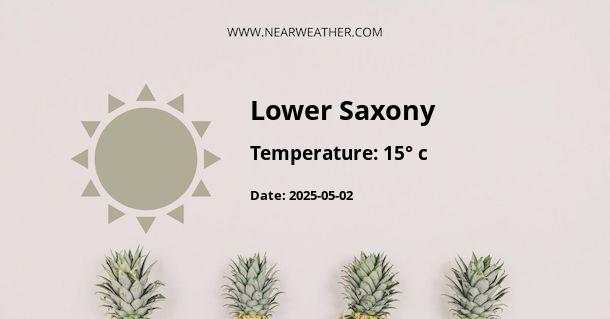Weather
11° 
Climate Conditions: moderate rain
Humidity: 94%
Wind speed: 10.37 km/h
Wind direction: 219°
Daily Weather Forecast
Saturday
11/01/2025
Climate Conditions: light rain
Humidity: 94%
Sunday
11/02/2025
Climate Conditions: light rain
Humidity: 92%
Monday
11/03/2025
Climate Conditions: overcast clouds
Humidity: 91%
Tuesday
11/04/2025
Climate Conditions: overcast clouds
Humidity: 85%
Wednesday
11/05/2025
Climate Conditions: scattered clouds
Humidity: 71%
Evolution
Daily Weather Forecast Evolution (°C)
Lowest temperature
Highest temperature
Other Information
Sunrise
07:14
Sunset
16:52
Latitude
52.000000
Longitude
10.000000
Timezone: GMT+05:30
More about Lower Saxony:
Climate and Weather in Niedersachsen, Germany
Niedersachsen, located in northwest Germany, is known for its diverse landscapes, ranging from the North Sea coast to the Harz Mountains. The region experiences a moderate maritime climate influenced by the North Sea and the Atlantic Ocean. The following is an in-depth look at the climate and weather patterns in Niedersachsen throughout the year.Seasonal Temperatures
Niedersachsen has mild summers and cool winters. The average temperature in summer (June to August) ranges from 20°C to 25°C (68°F to 77°F), making it a pleasant time to explore the region's outdoor attractions. However, temperatures can occasionally reach as high as 30°C (86°F) during heatwaves. Winter temperatures (December to February) in Niedersachsen can drop to around 0°C (32°F) or slightly below. Snowfall is not uncommon, especially in the Harz Mountains, where winter sports enthusiasts can enjoy skiing and snowboarding.Precipitation
Niedersachsen receives a moderate amount of rainfall throughout the year. The wettest months are generally from June to August, with an average precipitation of 60 to 80 mm (2.4 to 3.1 inches) per month. The coastal areas tend to experience slightly higher rainfall than inland regions. In contrast, the winter months from December to February have relatively lower precipitation levels, averaging around 30 to 40 mm (1.2 to 1.6 inches) per month. However, snowfall can significantly increase precipitation levels in certain areas, particularly in the Harz Mountains.Wind and Storms
Being located near the North Sea, Niedersachsen is occasionally affected by strong winds and storms. The region experiences the highest wind speeds during the winter months. The coastal areas are particularly susceptible to strong gusts due to their exposure to the open sea. Niedersachsen is also prone to storms, especially during the transition seasons of spring and autumn. These storms can bring heavy rainfall, strong winds, and occasionally, thunderstorms. It is important to stay updated with weather forecasts and warnings during such periods.Sunshine Hours
Niedersachsen enjoys a reasonable amount of sunshine throughout the year. During the summer months, the region receives an average of 7 to 8 hours of sunshine per day. The longest days occur in June, with daylight hours extending until late evening. In winter, the daylight hours decrease significantly, with an average of 1 to 2 hours of sunshine per day. However, the region experiences longer daylight hours compared to more northern parts of Germany.Climate Zones
Niedersachsen can be divided into two main climate zones: the coastal zone and the inland zone. The coastal zone experiences a maritime climate, characterized by mild winters and cool summers. The proximity to the North Sea moderates temperature extremes, resulting in relatively mild year-round temperatures. However, coastal areas also experience more precipitation and higher humidity levels compared to the inland regions. The inland zone of Niedersachsen has a more continental climate. Winters can be colder than in the coastal areas, with a higher chance of snowfall. Summers tend to be warmer, and the temperature fluctuation between day and night is more pronounced. However, the overall climate in this zone remains temperate.Extreme Weather Events
While Niedersachsen generally experiences mild weather, it is not immune to extreme weather events. Severe storms and flooding can occur, particularly in low-lying areas and along the riverbanks. The region has implemented various measures to mitigate flood risks, including the construction of flood protection systems. In recent years, Niedersachsen has also experienced heatwaves, which have become more frequent due to climate change. These heatwaves can lead to increased health risks and the need for adequate measures to protect vulnerable populations.Conclusion
Niedersachsen, with its diverse landscapes and moderate maritime climate, offers a pleasant environment for both residents and visitors. The region experiences mild summers, cool winters, and a reasonable amount of rainfall throughout the year. While occasional storms and extreme weather events can occur, Niedersachsen generally enjoys a temperate climate that allows for year-round outdoor activities.FAQ's about Lower Saxony's Weather:
Q - What is the Latitude and Longitude of Lower Saxony?
A - Lower Saxony's Latitude is 52.000000 & Longitude is 10.000000.
Q - What is the weather in Lower Saxony today?
A - Weather in Lower Saxony is 11° today.
Q - What is the climatic condition of Lower Saxony today?
A - Climate Conditions in Lower Saxony shows moderate rain today.
Q - What is the humidity in Lower Saxony today?
A - Humidity in Lower Saxony is 94% today.
Q - What is the wind speed in Lower Saxony today?
A - Wind speed in Lower Saxony is 10.37 km/h, flowing at 219° wind direction. today.

Nearby Locations
Latest searched locations